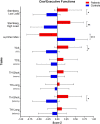Positive symptoms of schizophrenia and their relationship with cognitive and emotional executive functions
- PMID: 35960384
- PMCID: PMC9374871
- DOI: 10.1186/s41235-022-00428-z
Positive symptoms of schizophrenia and their relationship with cognitive and emotional executive functions
Abstract
Background: Positive symptoms of schizophrenia are associated with significant difficulties in daily functioning, and these difficulties have been associated with impaired executive functions (EEFF). However, specific cognitive and socio-emotional executive deficits have not been fully established.
Objective: The present study has several objectives. First, we aimed to examine the specific deficits in cognitive and socio-emotional EEFF in a group of patients with schizophrenia with a predominance of positive symptoms, as well as to determine if these patients present clinically significant scores in any of the three fronto-subcortical behavioral syndromes: Dorsolateral, Orbitofrontal, or Anterior Cingulate.
Method: The sample consisted of 54 patients, 27 with a predominance of positive symptoms, and 27 healthy controls matched for gender, age, and education. The two groups completed four cognitive and three socio-emotional EEFF tasks. In the group of patients, positive symptoms were evaluated using the scale for the Evaluation of Positive Symptoms (SANS), while the behavioral alterations associated with the three fronto-subcortical syndromes were evaluated using the Frontal System Behavior Scale (FrSBe).
Results: The patients, in comparison with a control group, presented specific deficits in cognitive and socio-emotional EEFF. In addition, a high percentage of patients presented clinically significant scores on the three fronto-subcortical syndromes.
Conclusion: The affectation that these patients present, in terms of both cognitive and emotional components, highlights the importance of developing a neuropsychological EEFF intervention that promotes the recovery of the affected cognitive capacities and improves the social and emotional functioning of the affected patients.
Keywords: Cognitive executive functions; Socio-emotional executive functions; Schizophrenia; Fronto-subcortical syndromes; Positive symptoms.
© 2022. The Author(s).
Conflict of interest statement
The authors declare that they have no competing interests.
Figures




Similar articles
-
"Cool" and "Hot" Executive Functions in Patients With a Predominance of Negative Schizophrenic Symptoms.Front Psychol. 2020 Nov 5;11:571271. doi: 10.3389/fpsyg.2020.571271. eCollection 2020. Front Psychol. 2020. PMID: 33250814 Free PMC article.
-
[Frontal dementia or dementia praecox? A case report of a psychotic disorder with a severe decline].Encephale. 2003 Mar-Apr;29(2):172-80. Encephale. 2003. PMID: 14567169 French.
-
[Cognition, schizophrenia and the effect of antipsychotics].Encephale. 2006 May-Jun;32(3 Pt 1):341-50. doi: 10.1016/s0013-7006(06)76162-0. Encephale. 2006. PMID: 16840928 Review. French.
-
Cognitive deficits and its relation with psychopathology and global functioning in first episode schizophrenia.Asian J Psychiatr. 2013 Dec;6(6):537-43. doi: 10.1016/j.ajp.2013.07.002. Epub 2013 Aug 13. Asian J Psychiatr. 2013. PMID: 24309868
-
[Hypofrontality and negative symptoms in schizophrenia: synthesis of anatomic and neuropsychological knowledge and ecological perspectives].Encephale. 2001 Sep-Oct;27(5):405-15. Encephale. 2001. PMID: 11760690 Review. French.
Cited by
-
Reduced slow wave density is associated with worse positive symptoms in clinical high risk: An objective readout of symptom severity for early treatment interventions?Psychiatry Res. 2024 Mar;333:115756. doi: 10.1016/j.psychres.2024.115756. Epub 2024 Jan 24. Psychiatry Res. 2024. PMID: 38281453 Free PMC article.
-
High-Density Lipoprotein Correlates with Cognitive Functioning in Schizophrenic Women.Brain Sci. 2024 Jul 12;14(7):699. doi: 10.3390/brainsci14070699. Brain Sci. 2024. PMID: 39061439 Free PMC article.
-
Effects of Exercise on Positive Symptoms, Negative Symptoms, and Depression in Patients with Schizophrenia: A Systematic Review and Meta-Analysis.Int J Environ Res Public Health. 2023 Feb 20;20(4):3719. doi: 10.3390/ijerph20043719. Int J Environ Res Public Health. 2023. PMID: 36834415 Free PMC article.
-
Roles of AMPA receptors in social behaviors.Front Synaptic Neurosci. 2024 Jul 11;16:1405510. doi: 10.3389/fnsyn.2024.1405510. eCollection 2024. Front Synaptic Neurosci. 2024. PMID: 39056071 Free PMC article. Review.
-
Accuracy of machine learning methods in predicting prognosis of patients with psychotic spectrum disorders: a systematic review.BMJ Open. 2025 Feb 25;15(2):e084463. doi: 10.1136/bmjopen-2024-084463. BMJ Open. 2025. PMID: 40000074 Free PMC article.
References
-
- Abu-Akel A. Impaired theory of mind in schizophrenia. Pragmatics & CognitionPragmatics and Cognition. 1999;7(2):247–282. doi: 10.1075/pc.7.2.02abu. - DOI
-
- Allport DA, Styles EA, Hsieh S. Shifting intentional set: Exploring the dynamic control of tasks. In: Umilta C, Moscovitch M, editors. Attention and Performance IV. MIT Press; 1994. pp. 421–452.
